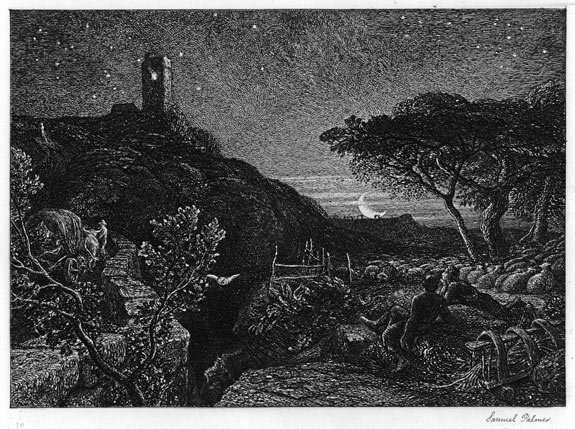|
Samuel
Palmer
(Newington,
south London 1805 – 1881 Redhill, near
Reigate, Surrey)
The
Lonely Tower

The Lonely Tower
Alexander 12 vi/vi, Lister 12 vi/vii
192 x 254 mm (plate); 168 x 235 mm (image); 290 x 440 mm (sheet)
Etching,
1879. The plate signed. First published state,
with the plate number 16 added and the plate bevelled.
Signed in pencil. One of the Twenty-one Etchings
by the Etching Club, published by H Blair Ansdell
December 1879. Total edition of
100, of which 75 were for sale and 25 for Club
members. On japan with wire lines. Short printing
ink stain in the top right border.
Sold
|
|
Additional
Information about the Print
Palmer
was inspired by Milton’s
lines that follow on immediately after those
mentioning the bellman in Il Penseroso
Or let my lamp at midnight hour,
Be seen in some high lonely tow’r,
Where I may oft out-watch the Bear
In
a fragment of an undated letter to Valpy Palmer
commented on The Lonely Tower
Here
poetic loneliness has been attempted; not the
loneliness of a desert, but a secluded spot in
a genial, pastoral country, enriched also by
antique relics, such as those so-called ‘Druidic
stones’ . The constellation of the ‘Bear’ may
help to explain that the building is the tower
of Il Penseroso. Two
shepherds, watching their flocks, speak together
of the mysterious light above them.
In
the etching Palmer developed the composition
of the original exhibited watercolour, giving
more emphasis to the tower and the stars, the
wagon and road on the left and the chasm between
them and the shepherds, and introducing low on
the horizon a crescent moon; an intensified fervent
focus which obviously pleased him, as he transferred
it to a small watercolour, in almost the last
painting he did.
The
tower is that on Leith Hill, near Dorking, which
was visible from Palmer’s
painting room in Furze Hill House, Redhill. A particularly
poignant view for Palmer, as it was close to where
his elder son, the nineteen year old Thomas More,
had died in 1861.
The
plate of The Lonely Tower would prove
to have an exceptional continuing history. Cancelled
in 1880 after the Etching Club edition, its whereabouts
unknown, it re-surfaced in Liverpool in the 1920’s
and Henry Macbeth Raeburn restored it, removing
most of the traces of the scored lines of cancellation
(and with them much of the silhouette of the ‘druidic
stones’).
An edition was not printed until 1954, when Mary
Sholten printed 5 proofs and a numbered edition
of 25 on cream wove paper, though these did not
come onto the market till 1994. C H Welch printed
a further 21 impressions in 1962. Subsequently
the plate had been acquired by David Gould who
projected a new edition in 1972, to be printed
by Edgar Holloway. This was abandoned after about
10 impressions had been taken, when the Keating
forgeries of Palmer Shoreham paintings came to
light.
|